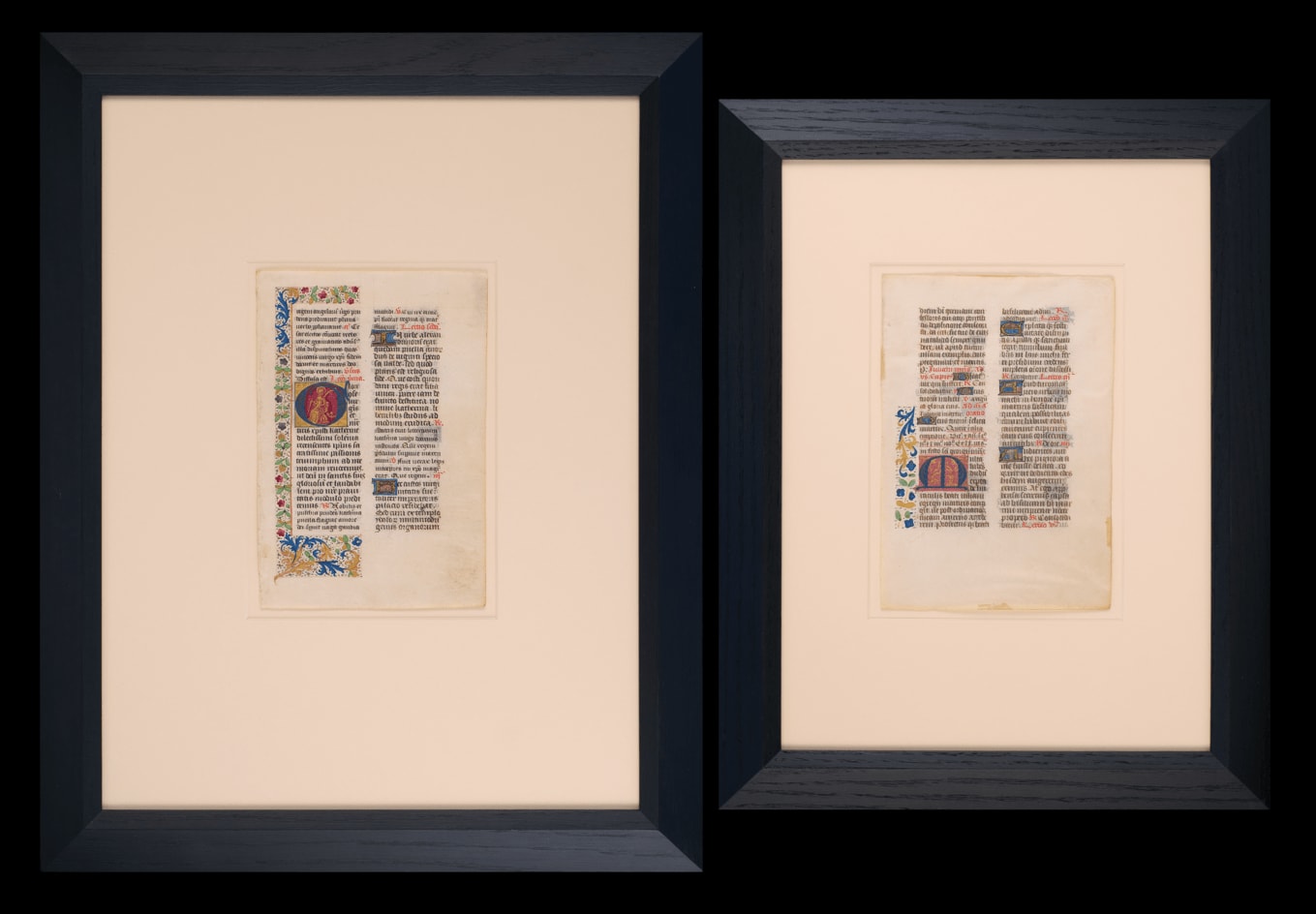 Saint Catherine (recto)
Saint Catherine (recto)
 Text leaf (recto)
Text leaf (recto)
Master of Jean Charpentier (active in Tours, second half of the 15th century)
Tempera, ink and gold on vellum.
Framed individually: 45.5 x 36 cm (Saint Catherine); 39.5 x 30 cm (text leaf).
Further images
The Master of Jean Charpentier is an important illuminator active in Tours, France, during the second half of the 15th century and who was most certainly trained in the workshop of the famous Jean Fouquet. He takes his name after the Book of Hours he painted c. 1480-1485 for Jean Charpentier, notary and secretary to King Louis XII and later mayor of Angers. This Book of Hours is now preserved in the Bibliothèque municipale d'Angers (ms. 2048). Early in his career, the Master of Jean Charpentier's style is closer to Jean Fouquet, evident in his more sophisticated brushstroke and elongated figures. During this period, he illuminated a remarkable copy of the Lamentation de Saint Bernard for the Duke of Nemours, Jacques d'Armagnac (now held in Paris, Bibliothèque nationale de France, ms. fr. 916). Toward the end of his career, the Master of Jean Charpentier's style evolved and became closer to that of Jean Bourdichon. In the 1480s and 1490s, he painted the Book of hours of Philippe de Commynes, a counselor and chamberlain to King Louis XI, which is now in the British Library in London (Harley 2863).
According to scientific literature, the Breviary of Saint-Julien de Tours, from which our two illuminated leaves originate, dates back to around 1470-1475 and is considered the earliest known work of the Master of Jean Charpentier. The camaïeu technique for the painting of Saint Catherine is reminiscent of the historiated initials in the renowned Hours of Etienne de Chevalier by Jean Fouquet (most leaves are now at the Musée Condé in Chantilly). It is no surprise that our present Saint Catherine, whose quality nearly exceeds other works by the Master of Jean Charpentier, was initially thought to be by a follower of Jean Fouquet.
Commissioned by the Abbey of Saint-Julien of Tours c. 1470-1475, the breviary remained in their possession for two centuries, as evidenced by a 17th-century handwritten note on the Lund fragment. The exact time the manuscript left the Abbey is unknown, but a 17th-century inscription on the fragment of the psalter may provide a clue: "faict par moy Christophe G[er]ault (?) / commendement fait à Monsieur le lieutenant sivil [et] criminel / Iacque". By the late 18th or early 19th century, two fragments of the breviary surfaced in Sweden. The psalter became part of Baron Carl Göran Bonde's collection, possibly acquired during one of his diplomatic trips to France in 1801-1802. In the early 19th-century, the calendar and temporal fragments belonged to mathematician Christian Gissel Berlin.
Currently, six illuminated leaves from the Breviary of Saint-Julien of Tours, including the present two, are known and preserved in various collections worldwide.
Parent fragments and sister leaves
Calendar and temporal (Lund, Universitetsbiblioteket, Med. Hand. 38).
Psalter (Örebro, Brevens bruk, private collection).
Meeting at the Golden Gate (Williamstown, Williams College Museum, 79.10).
Christ resurrected (Keio, Keio University, Matsuda collection, ms. 130).
Annunciation (London, Sotheby's, June 6, 2000, lot 20).
Presentation to the Temple (collection Sion Segre Amar, 1910-2003, deposited in Basel, Universitätsbibliothek, Comites Latentes, Depositum des Historischen Museums Basel, CL 236).
Provenance
Part of the so-called Bréviaire de Saint-Julien de Tours, made in Tours (France) around 1470-1475 by the Master of Jean Charpentier for the abbey of Saint-Julien de Tours, where the manuscript is preserved until the 17th century.
Tours or Angers (France), taken by Christophe Gerault (?).
Dismembered by the end of the 18th century or the beginning of the 19th century, maybe in Sweden, where the baron Carl Göran Bonde (1757-1840) keeps the psalter and where the mathematician Christian Gissel Berlin (1800-1863) holds the calendar and the temporal, bound together. The provenance of our two leaves is as follows:
Saint Catherine: London, Christie's, June 2, 1999, lot 27; London, Christie's, December 8, 2015, lot 28; London, Christie's December 15, 2021, lot 25 (as "follower of Jean Fouquet"); Switzerland, private collection.
Text leaf: USA, private collection.
Literature
PUBLISHED IN (CITING THE PRESENT SAINT CATHERINE AND/OR THE KNOWN FRAGMENT FROM THE SAME MANUSCRIPT)
Catalogue des manuscrits de Saint-Julien de Tours. Paris, Bibliothèque nationale de France, ms. nouv. acq. lat. 137, fol. 2v, n° 11 [source].
Nyförvärv och nyupptäckter, exhibition catalogue (Stockholm, Nationalmuseum, December 13, 1987-March 6, 1988), ed. G. Böcker, Stockholm, 1987, p. 56, n° 60.
Corpus antiphonalium officii, ed. R.-J. Hesbert, Rome, 1985, vol. V., p. 10.
S. Gras, La vallée de la Loire à l'époque de Jean Fouquet: la carrière de trois enlumineurs actifs entre 1460 et 1480, PhD thesis, dir. A.-M. Legaré, University de Lille, 2016, vol. I, p. 210, note 505 ; vol. III, p. 155.
E. Adam, Le camaïeu d'or dans l'enluminure en France au XVe siècle. Une technique de réduction du coloris, Master thesis, dir. Ph. Lorentz, Université de Paris-Sorbonne, 2016, vol. I, p. 160, note 574.
The Ultimate Materiality. The Splendor of Western Medieval Manuscripts, exhibition catalogue (Keio, University of Keio, October 2019), ed. T. Matsuda, Keio, 2019, p. 58, n° 41.
C. Favre, "Remarques sur le bréviaire découpé de Saint-Julien de Tours", in Peindre à Angers et Tours aux XVe-XVIe siècles, dir. F. Elsig, Silvana Editoriale, Cinisello Balsamo, 2022, p. 117-121.
R. Villa, "Tours 1480-1520", in Peindre en France: 30 ans de recherche sur les manuscrits à peintures en France (1440-1520), dir. F. Elsig, D. Vanwijnsberghe & S. Gras, Cinisello Balsamo, 2025, p. 210-211, fig. 116.







